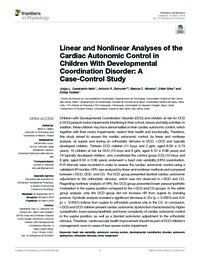Linear and nonlinear analyses of the cardiac autonomic control in children with developmental coordination disorder: A case-control study
Autor
Cavalcante Neto, Jorge L.
Zamunér, Antonio
Moreno, Bianca C.
Silva, Ester
Tudella, Eloisa
Fecha
2018Resumen
Children with Developmental Coordination Disorder (DCD) and children at risk for DCD (r-DCD) present motor impairments interfering in their school, leisure and daily activities. In addition, these children may have abnormalities in their cardiac autonomic control, which together with their motor impairments, restrict their health and functionality. Therefore, this study aimed to assess the cardiac autonomic control, by linear and nonlinear analysis, at supine and during an orthostatic stimulus in DCD, r-DCD and typically developed children. Thirteen DCD children (11 boys and 2 girls, aged 8.08 ± 0.79 years), 19 children at risk for DCD (13 boys and 6 girls, aged 8.10 ± 0.96 years) and 18 typically developed children, who constituted the control group (CG) (10 boys and 8 girls, aged 8.50 ± 0.96 years) underwent a heart rate variability (HRV) examination. R-R intervals were recorded in order to assess the cardiac autonomic control using a validated HR monitor. HRV was analyzed by linear and nonlinear methods and compared between r-DCD, DCD, and CG. The DCD group presented blunted cardiac autonomic adjustment to the orthostatic stimulus, which was not observed in r-DCD and CG. Regarding nonlinear analysis of HRV, the DCD group presented lower parasympathetic modulation in the supine position compared to the r-DCD and CG groups. In the within group analysis, only the DCD group did not increase HR from supine to standing posture. Symbolic analysis revealed a significant decrease in 2LV (p < 0.0001) and 2UV (p < 0.0001) indices from supine to orthostatic posture only in the CG. In conclusion, r-DCD and DCD children present cardiac autonomic dysfunction characterized by higher sympathetic, lower parasympathetic and lower complexity of cardiac autonomic control in the supine position, as well as a blunted autonomic adjustment to the orthostatic stimulus. Therefore, cardiovascular health improvement should be part of DCD children's management, even in cases of less severe motor impairment.
Fuente
Frontiers in Physiology, 9, 267Identificador DOI
doi.org/10.3389/fphys.2018.00267Colecciones
La publicación tiene asociados los siguientes ficheros de licencia:


